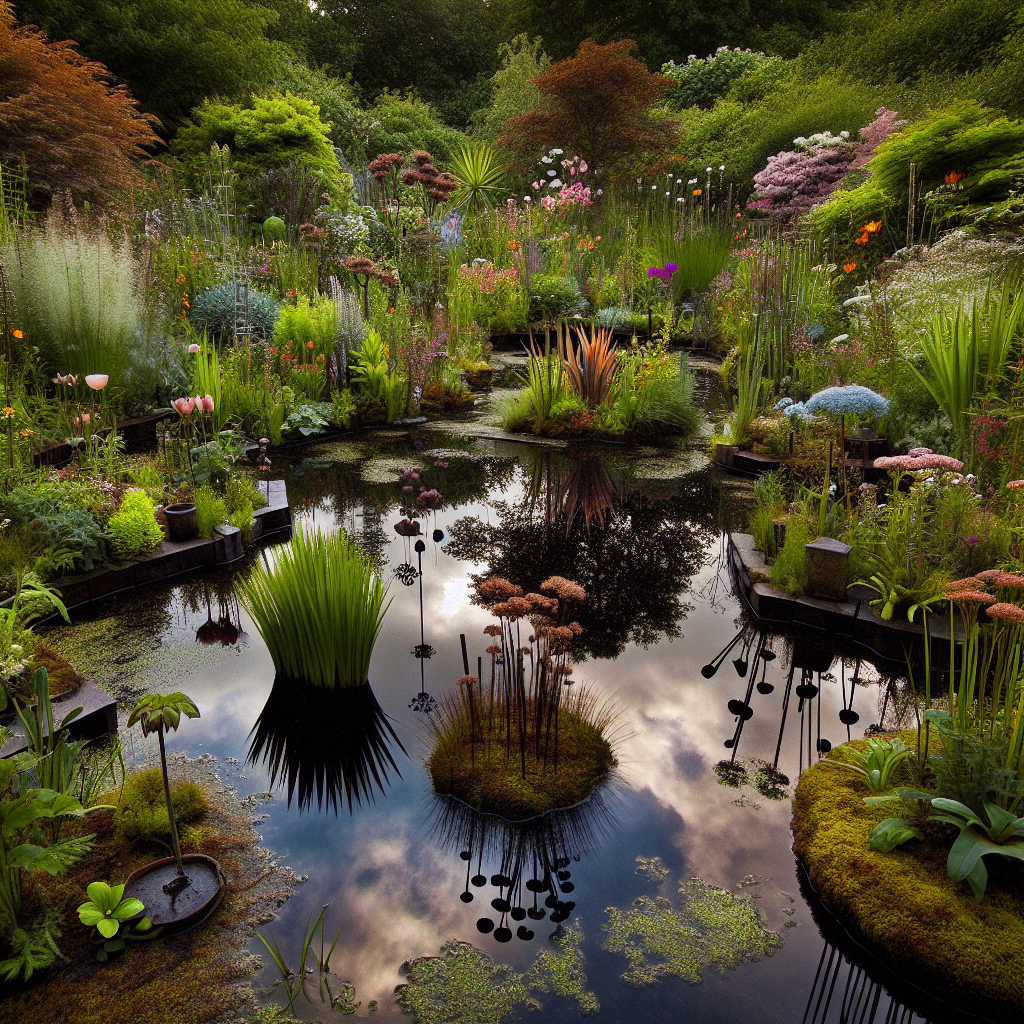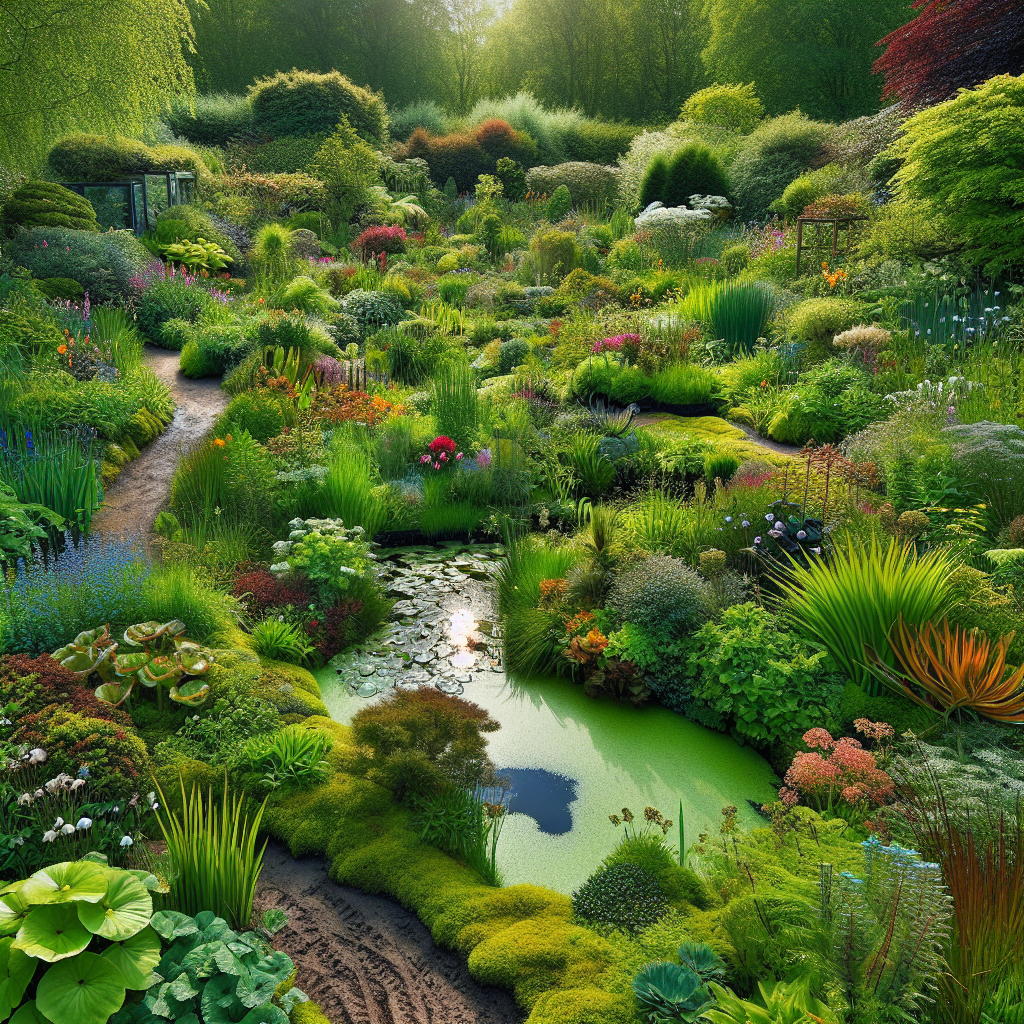
Imagine transforming a corner of your garden into a mesmerizing oasis, captivating guests with its unique beauty and vibrant colors. In the UK, creating a captivating bog garden has become a popular trend amongst gardening enthusiasts. By utilizing containers, you can effortlessly recreate this haven for moisture-loving plants and create a stunning focal point that thrives in wet conditions. Whether you have a sprawling backyard or a compact city patio, this guide will take you through the steps to create a beautiful bog garden in the UK, allowing you to enjoy the tranquility and serenity of nature right in your own outdoor space.

Choosing the Right Location
Assessing the Environmental Conditions
When choosing a location for your bog garden, it is important to assess the environmental conditions of the area. Look for a spot that receives a good amount of sunlight, preferably at least six hours a day, as many bog plants thrive in sunny conditions. However, you should also consider areas with partial shade if your garden is in a particularly hot climate.
Determining Soil Type
The soil type is a crucial factor to consider when planning a bog garden. Most bog plants prefer soil that is acidic and moisture-retentive. Conduct a soil test to determine the pH level and composition of your soil. If the pH level is too high, you may need to lower it by adding organic matter or using specific soil amendments. Additionally, if your soil drains too quickly, you may need to amend it to make it more moisture-retentive.
Considering Any Existing Water Sources
Bog gardens require a constant water source, as they rely on wet conditions to thrive. Consider any existing water sources on your property, such as natural springs, streams, or ponds, when choosing the location for your bog garden. If there are no natural water sources available, you can use a hose or irrigation system to maintain the necessary moisture levels. Just ensure that you can easily access water for your garden’s needs.
Designing Your Bog Garden
Creating a Planting Plan
Before you start planting, it is essential to create a planting plan for your bog garden. Consider the size and shape of your garden and decide how you want to arrange the different plants and features. You can create a sketch or use a garden design tool to visualize your plan. This will help ensure that your bog garden looks aesthetically pleasing and well-organized.
Selecting the Right Plants
Choosing the right plants is crucial for the success of your bog garden. Look for plants that are suited to boggy conditions and can tolerate the acidity and moisture levels of the soil. Some great options for bog gardens in the UK include Pitcher Plants, Sundews, Caltha Palustris (Marsh Marigold), and Iris Pseudacorus (Yellow Flag Iris). Research the specific needs and growing requirements of each plant before making your selections.
Creating Different Zones
Creating different zones within your bog garden can add visual interest and maximize the use of space. Consider incorporating different heights, textures, and colors of plants to create distinct areas. You can also use rocks or other hardscaping elements to define the different zones within your garden. This will give your bog garden a more dynamic and layered appearance.
Incorporating Hardscaping
In addition to plants, incorporating hardscaping elements can enhance the overall design of your bog garden. Consider adding features such as stepping stones, wooden boardwalks, or gravel paths to create pathways or seating areas. These elements can not only make your garden more accessible but also add a touch of charm and character to the space.
Adding Natural Features
To create a more natural and harmonious environment in your bog garden, consider adding natural features such as rocks, logs, or moss-covered branches. These elements can mimic the natural habitats of bog plants and provide additional visual interest. They can also offer hiding places for small wildlife, further enhancing the biodiversity of your garden.
Preparing the Site
Clearing the Area
Before you can start creating your bog garden, you need to clear the area of any existing vegetation or debris. Remove any weeds, grass, or unwanted plants from the designated space. This will allow you to have a clean and blank canvas for your bog garden project.
Preparing the Ground
Preparing the ground is an essential step to ensure the success of your bog garden. Start by loosening the soil to improve drainage and aeration. Remove any large rocks or debris from the area. If the soil is compacted, consider using a garden fork or a rototiller to break it up and create a more hospitable environment for your plants.
Installing Necessary Supports
Depending on the size and design of your bog garden, you may need to install supports such as retaining walls or edging materials. These supports will help contain the soil and prevent it from eroding or spilling over into adjacent areas. They can also give your bog garden a neat and polished look.
Creating Bog Areas
To ensure wet conditions for your bog plants, you will need to create specific areas within your garden that will hold water. Dig shallow depressions or create raised beds using water-retaining materials such as pond liners. These pockets will allow you to control the water level and ensure that your bog plants receive the necessary moisture.
Creating Proper Drainage
Installing a Pond Liner
To prevent water from seeping into the surrounding soil, you will need to install a pond liner in your bog garden. A pond liner acts as a barrier that keeps water contained within the designated areas. Choose a liner that is durable and resistant to punctures. Ensure that the liner is properly installed and covers the entire area required for your bog garden.
Adding Drainage Layers
To create proper drainage in your bog garden, add layers of porous material such as gravel or sand. These layers will help excess water to drain away from the roots of your plants, preventing waterlogging. The depth of the drainage layers will depend on the overall soil structure and the moisture requirements of your specific plant selections.
Establishing a Slope
To facilitate natural drainage and prevent water from becoming stagnant, it is important to establish a slight slope in your bog garden. The slope should direct water flow away from the planting areas and towards the designated drainage points. Take into consideration the natural landscape and elevation of your garden to determine the best slope angle.
Testing the Water Flow
Before planting your bog garden, test the water flow within the constructed drainage system. Fill the bog areas with water and observe how it drains away. Make any necessary adjustments to ensure a proper and consistent flow. If you notice any areas where water is not draining as expected, consider adding more drainage layers or adjusting the slope.

Planting Your Bog Garden
Choosing Bog-Friendly Plants
When it comes to selecting plants for your bog garden, choose those that are specifically adapted to wet environments. These plants, known as bog plants or water-loving plants, thrive in moist soil conditions and are capable of tolerating extended periods of waterlogged soil. Examples of bog-friendly plants include Marsh Marigold, Water Iris, Hardy Pitcher Plant, and Sphagnum Moss.
Creating a Planting Scheme
To create an aesthetically pleasing and cohesive look for your bog garden, create a planting scheme that takes into account the colors, heights, and textures of the plants. Consider grouping plants with similar needs together and arranging them in a way that complements their growth habits. Incorporate a mix of flowering plants, grasses, and foliage for variety and visual interest throughout the season.
Planting Techniques
When planting bog plants in your garden, consider the specific needs of each plant. Some may benefit from being submerged in water, while others prefer only wet soil conditions. Follow the planting instructions provided with each plant and ensure that they are placed at the appropriate depth and spacing. Take care not to damage the roots when handling the plants.
Adding Mulch
Adding a layer of organic mulch around the base of your bog plants can help conserve moisture and suppress weed growth. Mulch also helps regulate soil temperature and provides a finished look to your garden beds. Use materials such as bark chips, shredded leaves, or straw as mulch. Avoid using heavy or compacted mulch that may interfere with water drainage.
Maintaining Your Bog Garden
Watering the Garden
While your bog garden requires consistent moisture, it is important to strike a balance between too much and too little water. Monitor the soil moisture levels regularly and water accordingly. Avoid overwatering, as it can lead to root rot and other issues. Instead, aim for moist but not waterlogged soil for optimal plant health.
Fertilizing the Plants
Most bog plants do not require heavy fertilization. However, you can provide gentle nutrients to your plants by using organic fertilizers, such as compost or well-rotted manure. Apply fertilizers sparingly and follow the recommended application rates. Take care to avoid direct contact between the fertilizer and the plants’ leaves, as it may cause burns or damage.
Controlling Weeds
Weeds can compete with your bog plants for nutrients and space. Regularly inspect your garden for any signs of weed growth and promptly remove them. Use manual methods, such as hand-pulling or hoeing, to avoid introducing harmful chemicals to your bog garden. Mulching can also help suppress weed growth by blocking sunlight from reaching weed seeds.
Pruning and Dividing
Regular pruning and dividing can help maintain the health and appearance of your bog garden plants. Remove any dead or damaged foliage to promote new growth. Divide overcrowded plants to ensure they have enough space to thrive. Follow specific plant care instructions for each species, as pruning and dividing requirements may vary.
Monitoring for Pests and Diseases
Be vigilant in monitoring your bog garden for signs of pests or diseases. Common pests that may impact bog plants include slugs, snails, and aphids. There are various organic methods to control pests such as handpicking, trapping, or using companion planting techniques. If you notice any signs of diseases, such as leaf spots or wilting, take prompt action to prevent further spread and damage.

Adding Additional Features
Including Water Features
Adding water features, such as a small pond or a cascading waterfall, can significantly enhance the beauty and tranquility of your bog garden. The sound of running water and the visual appeal of aquatic plants can create a serene atmosphere. Ensure that the water features are properly integrated into the design and are accessible for maintenance purposes.
Integrating Seating Areas
Make your bog garden a welcoming space by integrating seating areas where you can relax and enjoy the surroundings. Consider adding benches, hammocks, or comfortable chairs strategically placed within your garden. Choose materials that are weather-resistant and suitable for wet environments to ensure their durability.
Enhancing Wildlife Habitats
Bog gardens have the potential to attract a variety of wildlife, including birds, bees, butterflies, and frogs. Enhance the habitats for these creatures by incorporating bird feeders, butterfly-friendly plants, and strategically placed rocks or logs as potential hiding spots for wildlife. Consider adding birdhouses or insect hotels to provide additional nesting opportunities.
Considering Safety and Accessibility
Installing Adequate Lighting
To ensure safety and visibility, install adequate lighting in and around your bog garden. Choose lighting fixtures designed for outdoor use and ensure they are properly installed and weatherproof. Lighting can also create a magical ambiance in your garden during evenings or nighttime visits.
Ensuring Proper Signage
If your bog garden is open to the public or you anticipate visitors, it is essential to install proper signage. Signage can provide information about the plants, explain any safety guidelines, and enhance the overall educational experience of the visitors. Ensure that the signs are weather-resistant and placed strategically for maximum visibility.
Creating Accessible Paths
Make your bog garden accessible to all by creating pathways or boardwalks that enable people of all abilities to navigate the space easily. Use materials that are slip-resistant, such as wooden decking or gravel, and ensure that the paths are wide enough to accommodate wheelchair users or those with mobility aids.
Addressing Potential Hazards
Regularly inspect your bog garden for any potential safety hazards, such as loose or slippery surfaces, sharp objects, or unstable structures. Repair or replace any damaged features to prevent accidents. Take measures to prevent children or pets from accessing any potentially dangerous areas, such as deep water features or thorny plants.

Garden Management and Sustainability
Managing Water Usage
While bog gardens require a constant water source, it is important to manage water usage efficiently. Consider installing a rainwater harvesting system to collect and store rainwater for use in your bog garden. Use drip irrigation or a soaker hose system to reduce water waste and ensure that water is delivered directly to the plants’ root zones.
Conserving Water Sources
To conserve water sources in your area, choose plants that are native or adapted to the local climate. Native plants are better suited to the natural rainfall patterns and require less supplemental irrigation. Additionally, use water-retaining mulch and organic matter in the soil to reduce evaporation and retain moisture.
Using Organic and Sustainable Practices
Promote sustainability in your bog garden by using organic gardening practices. Avoid the use of synthetic fertilizers, pesticides, and herbicides, as they can harm beneficial organisms and the overall ecosystem. Instead, use natural alternatives, such as compost, organic fertilizers, and integrated pest management techniques, to maintain a healthy and balanced environment.
Inspiration and Ideas
Exploring Different Bog Garden Styles
When designing your bog garden, draw inspiration from the various styles available. Some popular bog garden styles include naturalistic, Japanese-inspired, and contemporary designs. Naturalistic gardens aim to mimic natural bog habitats, while Japanese-style gardens focus on simplicity and harmony with nature. Contemporary designs often incorporate sleek lines, modern materials, and minimalist planting schemes.
Incorporating Art and Sculptures
Add a touch of artistic flair to your bog garden by incorporating art and sculptures. Choose pieces that are weather-resistant and suitable for outdoor environments. Art can serve as a focal point, enhancing the overall visual appeal of your garden and creating a unique and personal touch.
Drawing Inspiration from Existing Bog Gardens
If you are looking for ideas and guidance, visit existing bog gardens in your area or explore them online. Observing other gardens can inspire your own design choices and provide insights into plant selection, layout, and maintenance practices. Take note of the elements you like in each garden and consider how you can adapt and incorporate them into your own.
Creating a beautiful bog garden in the UK is a rewarding and enjoyable endeavor. By carefully choosing the right location, designing a well-thought-out plan, and properly preparing the site, you can create a unique and thriving bog garden. With proper maintenance and regular care, your bog garden will become a stunning and sustainable sanctuary for both plants and wildlife. Let your creativity flow while adhering to the specific needs of bog plants, and soon you will have a captivating and enchanting oasis right in your backyard.






